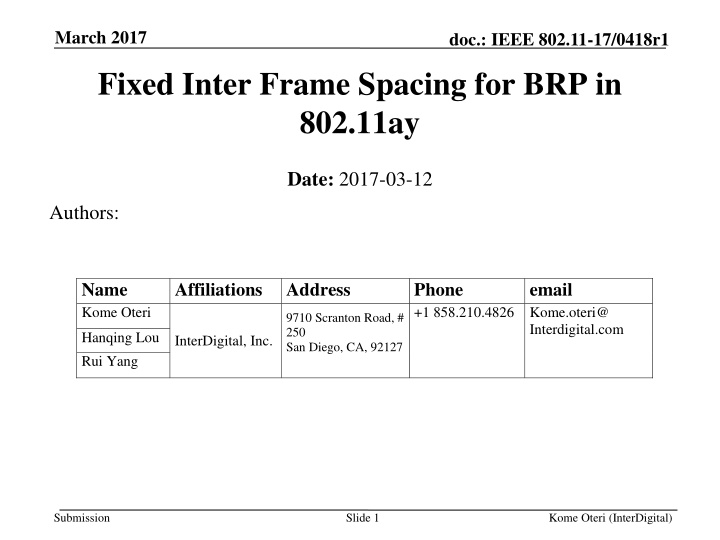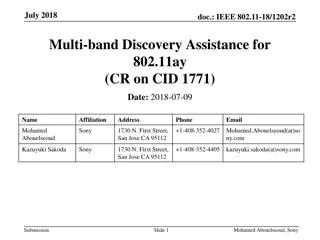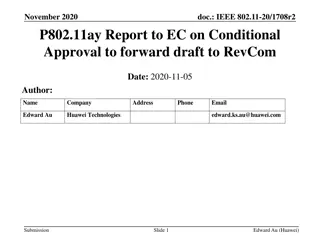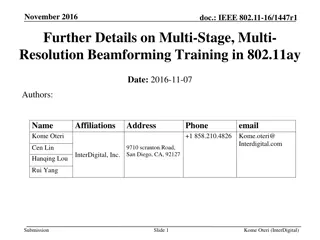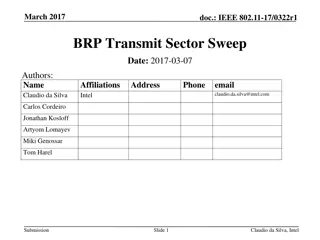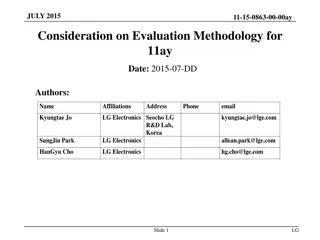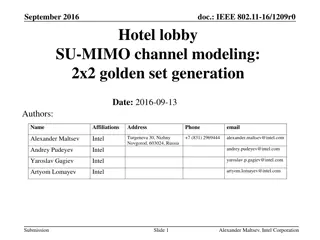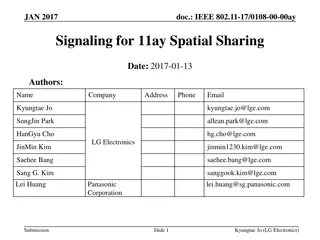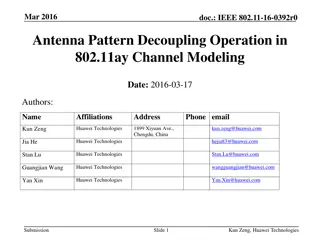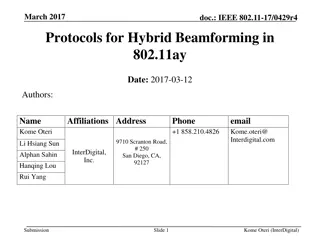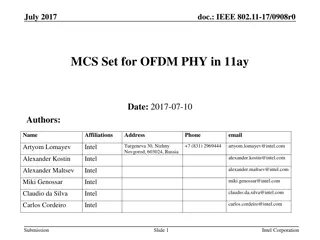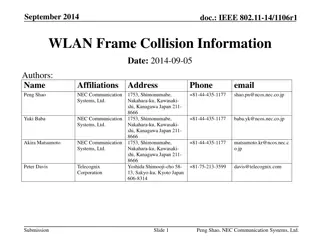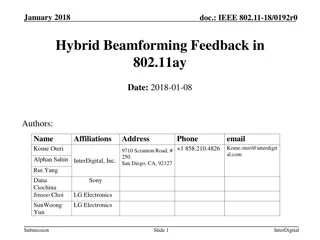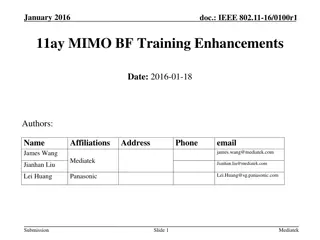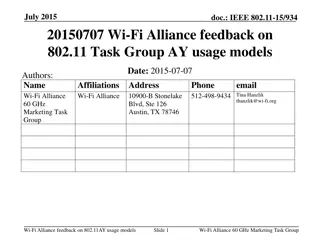IEEE 802.11-17/0418r1 Fixed Inter-Frame Spacing for BRP in 802.11ay
Enhancements in beamforming training procedures for IEEE 802.11ay are discussed, focusing on the Beam Refinement Protocol (BRP) and Inter-Frame Spacing (IFS) optimization. Proposals for improving BRP efficiency through IFS restriction to Short Inter-Frame Space (SIFS) are presented.
Download Presentation

Please find below an Image/Link to download the presentation.
The content on the website is provided AS IS for your information and personal use only. It may not be sold, licensed, or shared on other websites without obtaining consent from the author.If you encounter any issues during the download, it is possible that the publisher has removed the file from their server.
You are allowed to download the files provided on this website for personal or commercial use, subject to the condition that they are used lawfully. All files are the property of their respective owners.
The content on the website is provided AS IS for your information and personal use only. It may not be sold, licensed, or shared on other websites without obtaining consent from the author.
E N D
Presentation Transcript
March 2017 doc.: IEEE 802.11-17/0418r1 Fixed Inter Frame Spacing for BRP in 802.11ay Date: 2017-03-12 Authors: Name Kome Oteri Affiliations Address Phone +1 858.210.4826 Kome.oteri@ email 9710 Scranton Road, # 250 San Diego, CA, 92127 Interdigital.com Hanqing Lou Rui Yang InterDigital, Inc. Submission Slide 1 Kome Oteri (InterDigital)
March 2017 doc.: IEEE 802.11-17/0418r1 Introduction In 802.11ay, enhancements to the 802.11ad beamforming training procedures have been agreed on for complexity reduction, efficiency and to enable MIMO BF training [1][2][3][4]. In [5][6] and [7], we proposed and studied the implementation of a multi- stage, multi-resolution beamforming training (MR BFT) framework based on the 802.11ad Beam Refinement Protocol (BRP) and proposed improvements to the BRP procedure to enable efficient BRP. The improvements concluded that : 11ay BRP protocol should allow negotiation of the value of aBRPminSCblocks <=18 [4] In this contribution, we discuss further improvement by proposing the restriction of the IFS between the BRP frame and the response from the STA. The 11ay BRP protocol may transmit a response at a SIFS duration after reception of the BRP frame Submission Slide 2 Kome Oteri (InterDigital)
March 2017 doc.: IEEE 802.11-17/0418r1 IFS Optimization IFS has a very large effect on the efficiency of BRP feedback. As such there is a need to optimize IFS to improve efficiency of BRP [6]. There are two options to optimize the IFS for the BRP: Negotiate the values of the IFS : Improves BRP efficiency (not agreed) [7] Restrict the IFS to SIFS only : Eliminates channel access ambiguity (further discussion) Submission Slide 3 Kome Oteri (InterDigital)
March 2017 doc.: IEEE 802.11-17/0418r1 Restrict the IFS to SIFS only The responder transmits a response to the initiator after a SIFS duration on reception of the BRP measurement frame. If the response is available, the STA sends the response at a SIFS duration after the frame is received. If the response is not available: Option 1: The responder may respond by transmitting one or more PPDUs to the requesting STA (e.g. ACK) at a SIFS duration after the frame is received. STA may contend for the channel at a later time AP may poll the STA at a later time Option 2: The STA may transmit dummy information until information is ready e.g L- STF Submission Slide 4 Kome Oteri (InterDigital)
March 2017 doc.: IEEE 802.11-17/0418r1 Response Transmission with SIFS only TRN IFS = SIFS; response not ready Responder contends for channel ? SIFS = IFS ACK response TRN TRN IFS = SIFS; response not ready initiator poll T SIFS = IFS ACK/T response IFS = SIFS; response not ready Responder occupies channel TRN SIFS = IFS STF STF STF response Submission Slide 5 Kome Oteri (InterDigital)
March 2017 doc.: IEEE 802.11-17/0418r1 Summary We present details on IFS Optimization by proposing to: Restrict the IFS to SIFS only to eliminate channel access ambiguity while optimizing the IFS for the beam refinement procedure. We also propose different schemes to recover in the event the response from the responder is not ready Submission Slide 6 Kome Oteri (InterDigital)
March 2017 doc.: IEEE 802.11-17/0418r1 References 1. 2. IEEE 802.11-16/0100r3, MIMO BF Training Enhancements, Wang et. al., Jan 2016 IEEE 802.11-16/0316r0, Low Complexity Beamtraining for Hybrid MIMO, Fellhauer et. al., March 2016 IEEE 802.11-16/0420r1, BF Training for SU MIMO, Huang et. al., March 2016 IEEE 802.11-15/1358r5, Specification Framework for TGay, Cordeiro, August 2016 IEEE 802.11-16/1175r0, Multi-Stage, Multi-Resolution Beamforming Training for 802.11ay, Oteri et. al., September 2016 IEEE 802.11-16/1447r1, Further Details on Multi-Stage, Multi-Resolution Beamforming Training in 802.11ay, Oteri et. al., November 2016 IEEE 802.11-17/0041r1, BRP Optimization in 802.11ay, Oteri et. al., January 2017 3. 4. 5. 6. 7. Submission Slide 7 Kome Oteri (InterDigital)
March 2017 doc.: IEEE 802.11-17/0418r1 Straw Poll 1 Do you agree to add a mechanism to the 802.11ay specification to perform the following ? In the 11ay BRP protocol there shall be an option for the BRP frame to function as an action ACK frame. The procedure to recover feedback if the response is not ready is TBD Submission Slide 8 Kome Oteri (InterDigital)
March 2017 doc.: IEEE 802.11-17/0418r1 Appendix Submission Slide 9 Kome Oteri (InterDigital)
March 2017 doc.: IEEE 802.11-17/0418r1 TxOP Comparison Assumptions Tc=0.57 ns MAC data=42 Bytes (assumes no channel measurement feedback) Using any MCS would lead to a codeword less than the minimum block requirement Zero padding to aBRPminSCblocks=18 (this affects BRP_training frame size) AGC and TRN-T Training length N:1<= N<= 32 (N~5 bits) AGC=4N*64*5=1280N TRN-T=(CE+TRN_subfield*4)*N=(1024+128+128*5*4)*N=3712N IFS (Interframe spacing) At least a SIFS interval and at most a BRPIFS interval to ensure sufficient time for the complete transmission of frames SIFS=3 us; BRPIFS=44 us Analysis will compare SR BRP with MR BFT Vary number of beams and MR levels: 16 beams ( 2 level), 64 beams (3 level), 256 beams (4 level) Note: 802.11ad BRP packet supports up to 32*4=128 beams. However, we assume 256 beams can be trained within one packet here. Otherwise, two separate BRP training packets are needed for SR Study effect of IFS (3 usec <= IFS <= 44 usec) and BRP_training size (1 <= SCBlock <= 18) Assume BRP feedback frame size will stay the same Submission Slide 10 Kome Oteri (InterDigital)
March 2017 doc.: IEEE 802.11-17/0418r1 TxOP Comparison Multi-resolution beamforming training TXOP_SIFS=# of levels*(BRP_training+SIFS+BRP_feedback+SIFS)-SIFS TXOP_BRPIFS=# of levels*(BRP_training+BRPIFS+BRP_feedback+BRPIFS)-BRPIFS Single-resolution beamforming training TXOP_SIFS=BRP_training+SIFS+BRP_feedback TXOP_BRPIFS=BRP_training+BRPIFS+BRP_feedback Observations Multi-resolution beamforming training has a shorter training packet but a larger number of training and feedback packets IFS, BRP_training and BRP feedback have impact on the time duration Submission Slide 11 Kome Oteri (InterDigital)
March 2017 doc.: IEEE 802.11-17/0418r1 Results 2-Level Results: 16 beams 3-Level Results: 64 beams MR BFT with existing BRP parameters Parameters BRP_training size: 1 <= SCBlocks <=18 IFS duration: SIFS (3) <= IFS<=BRPIFS (44) Observation As resolution increases, MR BFT shows improved performance over SR BFT if BRP_training size and IFS are modified 4-Level Results: 256 beams Submission Slide 12 Kome Oteri (InterDigital)
March 2017 doc.: IEEE 802.11-17/0418r1 Results Summary Metric: uSec BRP_training Size numSC Blocks = 18 IFS 2-Level 45.63 29.85 -15.78 3-Level 69.9 63.99 -5.91 4-Level 94.25 200.6 106.35 MR TXOP_SIFS (3) SR TXOP_SIFS (3) Difference MR TXOP_xIFS (23) SR TXOP_xIFS (23) Difference 105.6 49.85 -55.75 169.9 83.99 -85.91 234.3 220.6 -13.7 Observations Observation 1 (O1): Optimizing both IFS and BRP training frame size show improvements for both SR and MR BFT. SR drops from 241 usec to 215 usec MR drops from 381 usec to 213 usec Observation 2 (O2): MR BFT shows improved performance over SR BFT as the beam resolution increases Note that up to 2048 beams may be supported MR TXOP_BRPIFS (44) SR TXOP_BRPIFS (44) Difference 168.6 70.85 -97.75 274.9 104.99 -169.91 381.3 241.6 -139.7 numSC Blocks =9 MR TXOP_SIFS (3) SR TXOP_SIFS (3) 35.12 25.6 -9.52 58.74 59.74 1 73.24 195.3 122.06 O1 MR TXOP_xIFS (23) SR TXOP_xIFS (23) Difference 95.12 44.6 -50.52 154.2 78.74 -75.46 213.2 215.3 2.1 O2 MR TXOP_BRPIFS (44) SR TXOP_BRPIFS (44) Difference 158.1 65.6 -92.5 259.2 99.74 -159.46 360.2 236.3 -123.9 numSC Blocks =1 MR TXOP_SIFS (3) SR TXOP_SIFS (3) 25.78 19.93 -5.85 40.17 54.07 13.9 54.56 190.7 136.14 MR TXOP_xIFS (23) SR TXOP_xIFS (23) Difference 85.78 39.93 -45.85 140.2 74.07 -66.13 194.6 210.7 16.1 MR TXOP_BRPIFS (44) SR TXOP_BRPIFS (44) Difference 148.8 60.93 -87.87 245.2 95.07 -150.13 334.6 231.7 -102.9 SR < MR MR < SR Submission Slide 13 Kome Oteri (InterDigital)
